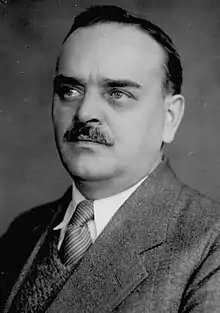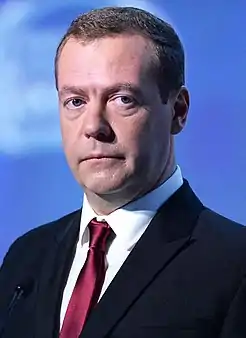List of heads of state of Russia
This is the list of the heads of state of Russia. For a more detailed, but shorter list (encompassing only the heads of state after 1991), go to List of presidents of Russia. For leaders prior to 1917, see List of Russian rulers.
Provisional Government
With the abdication of Emperor Nicholas II in the February revolution of 1917, power in Russia passed to a Provisional Government formed by the liberal leadership of the Duma. Grand Duke Michael had refused to ascend to his older brother's throne without the consent of an elected Constituent Assembly, and it was broadly assumed that the Assembly would be the only body with the authority to change the form of government. However after a failed coup attempt against the Provisional Government the Russian Republic was proclaimed. The elections were scheduled for 25 [O.S. 12] November 1917.
| # | Picture | Name | Term of office | Party | ||
|---|---|---|---|---|---|---|
| Ministers-Chairmen of the Russian Provisional Government (1917) | ||||||
| 1 |  |
Georgy Lvov | 15 [O.S. 2] March 1917 | 21 [O.S. 8] July 1917 | KD | |
| 2 |  |
Alexander Kerensky | 21 [O.S. 8] July 1917 | 7 November [O.S. 25 October] 1917 | PSR (Trudovik faction) | |
Civil War
Russian Soviet Federative Socialist Republic
After the October Revolution, the Russian Soviet Federative Socialist Republic was formed. Formally, the head of state was the Chairman of the All-Russian Central Executive Committee, but de facto the country was headed by Vladimir Lenin as the leader of the Bolshevik party and Chairman of the Council of People's Commissars.
| Chairmen of All-Russian Central Executive Committee | ||||||
|---|---|---|---|---|---|---|
| # | Picture | Name | Term of office | Party | ||
| 1 | .jpg.webp) |
Lev Kamenev | 9 November [O.S. 27 October] 1917 | 21 [O.S. 8] November 1917 | RSDLP(b) | |
| 2 |  |
Yakov Sverdlov | 21 [O.S. 8] November 1917 | 16 March 1919[1] | RSDLP(b)→ RCP(b) | |
| — |  |
Mikhail Vladimirsky Acting |
16 March 1919 | 30 March 1919 | RCP(b) | |
| 3 | .jpg.webp) |
Mikhail Kalinin | 30 March 1919 | 30 December 1922 | ||
Non-Bolshevik and Anti-Bolshevik Forces
Between the finalization of candidate lists and the election, the October revolution broke out, which ended the reign of the Provisional Government. A new government took charge of the country, the Council of People's Commissars. Nevertheless, it pledged to go ahead with the election and that its rule remained provisional until its authority would be confirmed by the Constituent Assembly.
The Constituent Assembly quorum met in the Tauride Palace in Petrograd, on 18–19 January [O.S. 5–6 Jan.] 1918. Viktor Chernov, leader of the Right SRs, was elected Chairman of the Assembly. The next day the Assembly declared dissolved by the Bolshevik government.
On 23 September 1918, the Act on the Formation of the All-Russian Supreme Power adopted by the State Conference in Ufa created the Provisional All-Russian Government (also known as Ufa Directory) and established that this government would be "until the convocation of the Russian Constituent Assembly". The Directory ceased to function as a result of the events of the night of November 17-18, 1918, when a group of Cossack troops deployed in Omsk arrested the members of the Directory, including its Chairman Nikolai Avksentiev. On the meeting of newly formed Council of Ministers the next day, Vice Admiral Alexander Kolchak, who was simultaneously promoted to full admiral, was elected to the post of Supreme Ruler. After Kolchak's arrest and execution in early 1920, the remaining leaders of the White movement refused to assume this title.
| Picture | Name | Term of office | Party | |||
|---|---|---|---|---|---|---|
| Chairman of Russian Constituent Assembly | ||||||
 |
Viktor Chernov | 18 [O.S. 5] January 1918 | 19 [O.S. 6] January 1918 | PSR | ||
| Chairman of Provisional All-Russian Government | ||||||
 |
Nikolai Avksentiev | 23 September 1918 | 18 November 1918 | PSR | ||
| Supreme Ruler of Russia | ||||||
 |
Alexander Kolchak | 18 November 1918 | 7 February 1920 | Military | ||
Russian Soviet Federative Socialist Republic as part of the Soviet Union
On 30 December 1922, the RSFSR became part of the Soviet Union. Until 1938, the head of the Russian Central Executive Committee remained the head of the republic. In 1938, the Supreme Council of the RSFSR was formed. Prior to 1990, de jure leader of the RSFSR, the Chairman of the Presidium of the Supreme Council, exercised only nominal powers. Following the adoption of amendments to the Constitution in 1989, the office of Chairman of the Presidium was removed, and the position of the Russian head of state passed directly to the Chairman of the Supreme Soviet in May 1990.
| # | Picture | Name | Term of office | Party | ||
|---|---|---|---|---|---|---|
| Chairman of All-Russian Central Executive Committee | ||||||
| 3 | .jpg.webp) |
Mikhail Kalinin | 30 December 1922 | 15 July 1938 | AUCP(b) | |
| Chairmen of the Presidium of the Supreme Soviet of RSFSR | ||||||
| 1 |  |
Aleksei Badayev | 19 July 1938 | 4 March 1944 | AUCP(b) | |
| — |  |
Ivan Vlasov Acting |
9 April 1943 | |||
| 2 |  |
Nikolay Shvernik | 4 March 1944 | 25 June 1946 | ||
| 3 |  |
Ivan Vlasov | 25 June 1946 | 7 July 1950 | ||
| 4 |  |
Mikhail Tarasov | 7 July 1950 | 16 April 1959 | AUCP(b)→ CPSU | |
| 5 |  |
Nikolai Ignatov | 16 April 1959 | 26 November 1959 | CPSU | |
| 6 |  |
Nikolai Organov | 26 November 1959 | 20 December 1962 | ||
| 7 |  |
Nikolai Ignatov | 20 December 1962 | 14 November 1966[1] | ||
| — |  |
Pyotr Sysoyev Acting |
14 November 1966 | 23 December 1966 | ||
| 8 |  |
Mikhail Yasnov | 23 December 1966 | 26 March 1985 | ||
| 9 |  |
Vladimir Orlov | 26 March 1985 | 3 October 1988 | ||
| 10 |  |
Vitaly Vorotnikov | 3 October 1988 | 29 May 1990 | ||
| Chairman of the Supreme Soviet of RSFSR | ||||||
| 1 | _(cropped).jpg.webp) |
Boris Yeltsin | 29 May 1990 | 10 July 1991 | CPSU→Independent | |
Russian Federation
On March 17, 1991, the all-Russian referendum on the introduction of the post of President of Russia was held. More than 70% of citizens voted for the introduction of the post of President, elected by direct vote. On 12 June 1991, Yeltsin won 57% of the popular vote in the presidential election.
| Presidents of the Russian Federation | ||||||
|---|---|---|---|---|---|---|
| # | Picture | Name | Term of office | Party | ||
| 1 | _(cropped).jpg.webp) |
Boris Yeltsin | 10 July 1991 | 31 December 1999[2] | Independent | |
| — | _03_(cropped).jpg.webp) |
Vladimir Putin Acting |
31 December 1999 | 7 May 2000 | ||
| 2 | Vladimir Putin | 7 May 2000 | 7 May 2008 | |||
| 3 |  |
Dmitry Medvedev | 7 May 2008 | 7 May 2012 | United Russia | |
| 4 | _03_(cropped).jpg.webp) |
Vladimir Putin | 7 May 2012 | incumbent | United Russia→Independent | |
References
- Died in office
- Resigned
